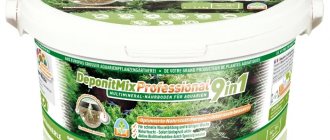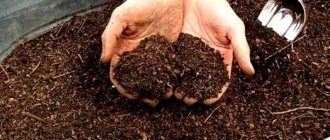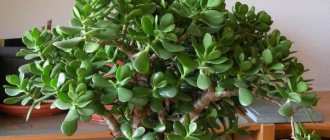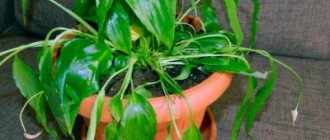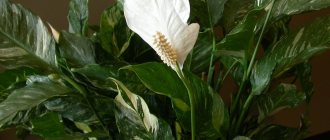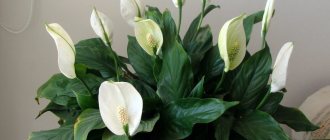The “female happiness” flower or spathiphyllum is an amazingly delicate plant with a beautiful legend. It is believed that its owner will be a happy wife and mother, loving and beloved. Only one condition must be met - the flower must be presented. But a favorable home environment alone is not enough for its successful maintenance. In order for the plant to delight with abundant flowering with a snow-white blanket and lush green color of the leaves, it is necessary to provide proper care: constant moderate watering, diffused lighting, regular replanting in the correct soil for spathiphyllum.
How to prepare soil at home
The ingredients must be mixed in a clean, treated container.
First, the base for the mixture is poured, and only then the additional ingredients. Lastly, disintegrants (sand, agroperlite) are added. Mix everything thoroughly so that the mass is homogeneous. In what soil to plant spathiphyllum:
- All ingredients must be fresh.
- You can open additional ingredients only immediately before mixing.
- Dosages must be correct.
- Before planting, be sure to measure the acidity level. If necessary, you will have to adjust it.
As soon as the substrate is ready and all the characteristics are suitable for the flower, you can begin planting.
How to improve purchased soil?
Ready-made soil mixtures are considered quite heavy. To make the soil lighter and airier, add to the mixture:
- vermiculite;
- perlite;
- brick edge;
- coarse sand.
Thus, the soil becomes breathable and loose. The amount of natural baking powder should be no more than 10% of the total volume of soil.
It is up to the grower to add any components to the finished mixture at his own discretion. However, it is better not to ignore this opportunity, to make the finished soil more acceptable for the plant.
How to choose a ready-made substrate
It is best to purchase a ready-made substrate at a gardening store rather than rack your brains over the question of what soil is needed for spathiphyllum and how to make it yourself.
Nowadays, it is not so difficult to find special soil for the flower of female happiness in stores. One of the suitable options is Vermion soil mixture. If you cannot find soil for spathiphyllum, a soil mixture for tropical plants or aroid crops is suitable. If you don’t find such soil mixtures, you can buy a universal soil, but you will have to carefully study the composition before purchasing and add additional ingredients.
It is better to choose a substrate whose packaging says that it is for spathiphyllum
What kind of soil is needed for spathiphyllum:
- Universal primer for the aroid family Seliger-Agro. The acidity level of this substrate is within 5-6. The composition includes river sand, peat, expanded clay, large-pored baking powder and a complex of mineral fertilizers specially selected for this group of plants.
- Another good substrate is BioMaster. The composition includes moss, biosoil, sand and charcoal.
- The substrate from Eco Sad is also suitable for planting the flower of female happiness. It consists of sand, moss, turf soil, peat, vermicompost, charcoal, agroperlite. All ingredients are laid in layers. You can mix them at your discretion.
Important! Universal soil mixtures usually have a high level of acidity and are too heavy for aroid crops. But purchased soil mixtures are not always suitable for plants. After transplantation, the first time you need to monitor the flower
And if it looks bad, you need to change the soil
After transplantation, the first time you need to monitor the flower. And if it looks bad, you need to change the soil
But purchased soil mixtures are not always suitable for plants. After transplantation, the first time you need to monitor the flower. And if it looks bad, you need to change the soil.
What can be added to purchased soil to improve it?
If you can’t find a soil with a suitable composition, you will have to buy a universal soil mixture and add other ingredients to it to improve it.
Before planting, sand, wood ash, coconut shavings, crushed tree bark or perlite are added to the universal soil for spathiphyllum.
Types of store-bought mixtures
Today, ready-made soil mixtures for Aroids are not a rare commodity. You can purchase it in specialized garden stores and flower shops. These products have approximately the same composition, but different manufacturers and, accordingly, prices.
- "Vermion" soil for spathiphyllum. The composition contains large quantities of organic components, nitrogen, as well as balanced levels of potassium and phosphorus. Suitable for all representatives of the Araceae family. The volume of soil in the bag is 2.5 liters, the price is 40 rubles.
- “Biomaster” for aroid plant species is a soil mixture made exclusively from natural, natural ingredients. Manufacturer – Russia. It is characterized by an optimal ratio of minerals for the full development of spathiphyllum. The composition includes sphagnum moss, which protects the roots of the plant from rotting. Volume 2 l, cost 54 rubles.
- "Agrosver" soil for spathiphyllum. The product is completely ready for use and does not require additional sterilization. The amount of soil mixture is designed for a pot with a capacity of up to 2 liters. The cost is about 30 rubles.
Selecting purchased soil
It makes no sense to list manufacturers or names of ready-made substrates for planting spathiphyllum - it can grow in almost everything if you add 1-2 components. This can be demonstrated by the example of three very different soils:
- “Azalea” is too heavy and acidic soil for spathiphyllum; it is diluted with coconut fiber and brick chips (fine expanded clay, perlite) 3:1:0.5;
- “Cactus” - the soil is too loose and contains few coarse fibers, as for female happiness, and is definitely not nutritious enough. Humus and acidic peat or sphagnum are added to it to balance the acidity 3:0.5:1;
- “Orchid” - the substrate contains practically no nutrients, too loose even for spathiphyllum, mixed with “Azalea” and humus 1: 1: 0.5.
But these compositions, although acceptable, are far from ideal; they are given as an example. Women's happiness will not be able to reach the peak of decorativeness in them.
In order for spathiphyllum to grow well, soil can be purchased at the store and improved at home:
- Universal soil for decorative foliage or flowering plants has a neutral or slightly acidic reaction. It is used in its pure form, but it is better to add a 20% mixture of manure and acidic peat (1:1).
- “Anthurium” or “Aroid” are soils with a good structure, but spathiphyllum lacks nutrients in them. The shortage is not critical, but it is still worth adding 20% of a mixture of humus and leaf soil (1:1) to the finished soil.
- “Violet” can be used in its pure form, or by mixing 20% dry rotted manure and pine bark (1:1).
Possible problems with illiterate care and ways to solve them
Main consequences:
- Does not bloom - the reason may be in the pot or soil. For spathiphyllum to bloom, it is planted in a small flowerpot (what pot is suitable for spathiphyllum?). If this measure does not help, then the soil is not selected correctly. Perhaps there is not enough potassium or phosphorus with excess nitrogen. Then the leaves grow actively. This means you need to add the missing fertilizers.
- Root rotting - if action is not taken in time, the flower will die. The reason is excess humidity. Possibly little added drainage. The only thing that will help is replanting it in new soil, where you add activated carbon and moss. Trim rotten roots and dry them. After transplanting, do not water for 2-3 days.
- The plant is withering - perhaps the soil is too dense. This may be due to a lack of natural raising agents. Either the soil has become outdated and has become lumpy over time. A transplant will help.
- Black spots appear - this indicates high acidity in the soil or an excess of fertilizers. Need an urgent transplant.
- The appearance of yellow spots - the leaves turn yellow, while the veins remain green. Possible iron deficiency. Spraying with iron chelate will help. It is better to replant in new soil.
- Parasites on the plant - most likely insects lived in the soil. Or it was poorly processed. It is necessary to replant and treat the soil and drainage.
Spathiphyllum is a beautiful and unpretentious flower. But it has special care features. It is not difficult to follow the rules and know the preferences of the plant. But it will protect you from problems and diseases. Moreover, the flower is picky mainly about the soil.
If you find an error, please select a piece of text and press Ctrl+Enter.
Plant in the wild
The tropical forests of South America are considered the birthplace of this plant. Exotics mainly grow in wetlands, flooded meadows, and on the banks of reservoirs.
Spathiphyllum does not like drought or excess moisture. Preference is given to moderately moist soil.
In nature, the flower grows in slightly acidic soils, which consist of:
- dry branches;
- sticks;
- rotted leaves;
- compost;
- charcoal.
How to choose a purchased mixture?
Ready-made mixtures are sold in flower shops, gardening departments, and on the market. There is a special soil for spathiphyllum. But it is also suitable for araceae, the family of which the flower belongs to.
However, it is worth considering that the mixture is not suitable for anthurium. It is also of the aroid family, but prefers low-lying peat. And all other related flowers love the mount. Such peat becomes compacted over time, which is detrimental to the root system of spathiphyllum.
Ready-made soils from different manufacturers vary in price and composition:
- There are completely natural soils, using natural components, for example, Russian-made “Biomaster” for aroids. Price per package of 2 kg from 50 rubles. It contains sphagnum moss.
- From cheap mixtures "Agrosver" for spathiphyllum. It is completely ready for planting and transplanting. The components are sterilized. For a package of 2 kg from 30 rubles.
- More expensive "Vermion" for aroids. It contains a lot of nitrogen, organic matter, potassium and phosphorus. Price per package of 2.5 kg from 40 rubles.
When choosing soil you need to focus on:
- to customer reviews;
- description of the composition (a bona fide manufacturer indicates all the components of the soil);
- what plants is it intended for?
- tips for use.
Ideal land for a flower
For indoor exotic plants, the components included in the soil mixture are of no small importance. Otherwise, he will wither away. And an unhealthy plant is a springboard for the development of many pathogenic infections. Therefore, the substrate must meet the following requirements:
breathability;- non-toxic;
- looseness;
- water permeability;
- ease;
- slightly acidic environment, pH 5-5.5.
Universal soil or soil for flowering plants may meet these parameters. It’s good if the prepared soil is designed specifically for spathiphyllum.
Main components of the substrate:
- leaf soil;
- peat;
- charcoal;
- expanded clay granules;
- sphagnum moss;
- fern roots;
- sand;
- mineral leavening agents.
Attention! As for moss, it is preferable to choose sphagnum; there will be no benefit from anything else. This component is used in the form of dust.
Instead of expanded clay, you can choose another drainage, at your discretion.
Stages of spathiphyllum transplantation
- Land preparation. It is correct to buy soil for transplanting spathiphyllum at home in a specialized store. So the composition and concentration of nutrients will correspond to the requirements of the plant. If it is not possible to buy ready-made soil for spathiphyllum, then you can prepare it yourself. You need to replant in slightly acidic soil. It is made up of turf soil, leaf soil, peat, and coarse river sand. It is also recommended to add additives to the soil in the form of charcoal, brick chips, and superphosphate.
- Preparing a pot or flowerpot. The choice of container for transplanting spathiphyllum at home depends on the size of the old pot. If you plan to leave the plant intact without planting the children, then you should take a pot two to three sizes larger than the previous one. When planting, you will need additional containers for new plants. When choosing what material the new container will be made of, you should give preference to natural clay. A drainage layer of expanded clay (2 cm) must be placed on the bottom of the new pot.
- Preparing the plant for transplantation. On the day of the planned transplant at home, the pot with spathiphyllum is well watered so that the soil becomes moist. This will make it easier to remove the plant from the pot and, if necessary, divide the rhizomes. Use a garden spatula to walk along the edge of the old pot, digging up the roots. The plant, along with the earthen lump, is pulled out of the container. The roots of an adult plant tightly entwine the entire soil. It is at this stage that spathiphyllum blooms. The root system must be gently cleaned of drainage and old soil. If the plant has flower stalks, then it is worth cutting them off with pruning shears so that it can use all its strength to take root in the new pot. Dried and wilted leaves are carefully removed or, if yielding, torn off.
- Rhizome division. Several rosettes can be separated from the entire mass of plants. This is the easiest way to propagate spathiphyllum at home. If it has not been replanted for a long time, then there may be a lot of young plants in the pot. When separating the children, the main task is to preserve the powerful rhizome behind each rosette of leaves. After dividing, you should inspect the roots. Rotten and too long ones are cut off.
- Planting spathiphyllum. To transplant spathiphyllum according to the rules at home, you need to follow simple tips. You need to replant carefully. Prepared soil is poured onto the expanded clay laid at the bottom of the pot or cache-pot up to half the volume. Spathiphyllum is placed in the middle of the pot and the root system is distributed over the surface. Next, add the substrate to the desired level. The plant should not be deepened into the soil, even if the root buds do not reach it. After some time, they will reach the ground and strengthen the flower even better. When the soil is poured, it should be compacted a little so that the plant does not sway and sits tightly in the ground. Then the spathiphyllum plantings are watered abundantly to eliminate voids in the soil. If at the end of watering a depression is formed, then it is necessary to add more soil and repeat the procedure of compacting and watering. After all manipulations, the leaves are sprayed to wash away dust and dirt.
- Caring for a transplanted plant. In the first month in a new pot, spathiphyllum is very demanding on humidity. Many gardeners even recommend setting up a mini-greenhouse for it. This is quite easy to do. You can place the plant along with the pots in a plastic bag and the greenhouse is ready. Spathiphyllum leaves need frequent spraying from a spray bottle. Spraying is best done early in the morning and at dusk and preferably twice a day. The soil should not be allowed to dry out, so it should be watered as soon as the top layer of soil dries out a little. To speed up root formation, the plant can be watered once with “Kornevin” or another preparation that stimulates root formation. You can also use root or foliar feeding with special fertilizers. It should be remembered that the plant will not bloom until the root system completely entwines the pot from the inside.
Popular articles Spathiphyllum cupido: caring for the plant at home
Proper transplantation of spathiphyllum and care at home after it will help the plant to recover and grow its root system in a short time. A healthy plant will delight with lush flowering and beautiful succulent foliage.
Procedure for transplantation
After purchasing, the plant needs to rest for several weeks and get used to the new environment, especially since moving from a flower shop to a new home is a stressful situation for it.
Important! It is necessary to replant spathiphyllum after purchase, regardless of the time of year and flowering stage. Store-bought soil is often oversaturated with fertilizers to accelerate the growth of the plant, which will have a detrimental effect on its growth in the future.
In the meantime, you need to prepare a new container and decide on the soil:
- The “new house” should be the same size as the purchased one if the roots have not completely filled it, or a couple of centimeters larger in volume if the root system is very tightly located in the purchased container. The material of the pot can be anything, but professional flower growers advise buying ceramics for “women’s happiness.”
- Due to the peculiarity of the spathiphyllum root system, it is preferable to choose wide, oblong-shaped pots.
- Large drainage holes are a necessity for our pet.
- Before planting, the pot for “happiness” must be doused with boiling water for disinfection.
- It is advisable to calcine the soil in the oven for about five minutes for the same purpose or treat it with special disinfectants that can be bought in the store.
Should the land for planting and replanting be different?
Growing an exotic flower from seeds is labor-intensive and does not always bring the desired results. When a gardener has such planting material in his hands, the question may arise: what kind of soil is needed to germinate spathiphyllum?
To renew the soil, sometimes replace the top layer in the pot
For producing seedlings, a sand-peat mixture is most suitable, as it is easier to maintain the required level of humidity and breathability. After the true leaves appear on the seedlings, they are dropped into the substrate with the addition of other components necessary for spathiphyllum.
In what soil should I plant an adult spathiphyllum? A mature specimen of a flower is transplanted into soil with a recommended composition close to natural.
How to ensure suitable soil when planting in open ground?
Sometimes gardeners use lush spathiphyllum bushes for landscaping their garden plots in the summer. When transferring the flower to open ground for the summer, dig a planting hole, drain it well and fill it with a suitable substrate.
Terms and rules of transplantation
The best time to transplant spathiphyllum is the end of winter - the beginning of spring. For young plants, the procedure is required annually. For three-year-old specimens, transplantation is carried out as needed, but at least once every three to four years. When the roots of the flower fill the entire pot, it is necessary to replant.
Features of plant transplantation:
- Before the procedure, the container is doused with boiling water. A drainage layer is placed at the bottom. Then comes filling with the nutrient mixture.
- The pot with the plant is placed on oilcloth and the bush is carefully pulled out. To pull it out faster, it is better to moisten the soil generously in the container.
- The root is freed from expanded clay crumbs and soil.
- Using scissors or a sharp knife, trim flower stalks, dry stems, and the bases of old leaves. If the bush is a very overgrown clump, then you can separate parts from it along with a healthy and strong rhizome for propagation.
All that remains is to plant the prepared bush of the plant in a new pot, sprinkle it with soil and water it generously. Replanting spathiphyllum means rejuvenating it, giving space for its further growth and flowering.
Fertilizer application timing
Spathiphyllum requires mineral supplements from the beginning of spring until the beginning of September. They will help the plant emerge from long hibernation after winter and begin to develop normally. Complex dry mixtures are diluted at a dosage of 1 gram per liter of water. The plant is first lightly watered, then watered with fertilizer. Pre-watering helps protect the plant's roots from burns. Nutrients will be distributed more evenly in moist soil. If a liquid complex fertilizer is used, you must follow the instructions for dilution and application of fertilizer.
Fertilizer must be applied regularly, only then will it benefit the plant. It is optimal to do this twice a month. If in winter it is possible to maintain the room temperature no higher than +16 degrees, fertilizing can be omitted. If the flower is kept in a warm room, fertilizer is applied about once every 30 days.
What microelements does spathiphyllum need?
The plant has its own specific feeding requirements. In particular, it practically does not need organic substances, which are so necessary for many other indoor flowers. All he needs in this regard is a small amount of them for foliage growth in order to increase the vegetative mass. But if you overdo it even a little with organics, you can forget about the flowering of “female happiness.”
But this indoor flower needs a wide variety of minerals. In addition to the usual set (potassium, phosphorus, nitrogen and magnesium), it is advisable to include iron, copper, manganese, boron and sulfur in the fertilizer complex.
The best fertilizer for flowering spathiphyllum
To stimulate the flowering process and during it, fertilizing should be done with a full range of mineral fertilizers weekly. It should be diluted in a 1:1 ratio with water. It is considered advisable to alternate mineral complexes with a weak mullein solution (at least 25-30 parts of water are taken for 1 part mullein). You should be very careful with organic matter, avoiding its excess. Very good reviews from flower growers involved in the cultivation of this crop are received by complexes that do not contain lime - “Azalea”, “Flower” and others.
Which container is not suitable?
- A young spathiphyllum of a small plant cannot be planted immediately in a large container, since it will not be able to grow in it at all (how to plant spathiphyllum?).
- It is better not to use wooden or glass pots for growing this flower, otherwise there is a high probability of rotting of the root system.
- If you want to use a dark or transparent flowerpot, it is better to place it in a flowerpot to protect the roots from excessive heat.
- In no case should you choose a deep and narrow flowerpot, since the root system of spathiphyllum has a peculiarity: it develops in width and not in depth.
Which land would be wrong?
- Spathiphyllum prefers moist soil, but stagnation of water leads to rotting of the roots.
- There must be a supply of air, that is, the soil must be loose.
- The flower loves slightly acidic soil.
- Moss added to the soil mixture will help prevent the soil from drying out.
Consequences of incorrect soil selection
If spathiphyllum is planted correctly, in compliance with all soil requirements, then it will not be susceptible to various diseases, will not dry out and will delight with lush flowering all year round, since this indoor plant has practically no dormant period. Otherwise, not very pleasant “surprises” are expected.
Even with proper, timely watering, moisture accumulates in dense, heavy soil, air exchange in the soil stops , which causes rotting of the roots, and, as a result, the growth and flowering of the indoor plant stops. This can lead to the death of the flower.
In general, in order for indoor plants to bloom, they need to be planted in small pots where they will be cramped. If, despite everything, “female happiness” does not bloom, the reason is the wrong soil and it needs to be changed or some loosening components added.
Alternatively, you can add potassium fertilizers.
Insufficient soil moisture or incorrectly selected acidity causes spots to appear on the leaves and generally weakens the flower. A weak, stunted plant is more easily susceptible to various diseases and pest invasions.
It should also be noted that the larvae of various insect pests may initially be present in poor-quality soil. The most common are scale insects, root aphids, and spider mites. Or sometimes you can notice how white beetles have appeared on the stems of leaves - this is most likely the so-called mealybug. Naturally, it is necessary to immediately take measures to destroy them: treat the soil or replant the plant in fresh soil.
If the soil is not thoroughly treated before planting, it may contain spores of various fungal diseases (root rot, phytospores). Heavy compressed soil that causes stagnation of water, or a cold window sill where there is a pot of spathiphyllum - all this will definitely lead to the death of the plant.
In conclusion, we can say that spathiphyllum is a fairly unpretentious flower. Knowledge of some rules and conditions of growth, continuous minimal care - and “female happiness” will bloom all year round and delight you with its fresh appearance.
Spathiphyllum transplant
After purchasing “female happiness,” it is recommended that after 2-3 weeks you transplant it into fresh soil that has the necessary looseness and nutritional value. This procedure ensures good development of the plant.
Then the plant is regularly transplanted into a new pot, which is slightly larger in size than the previous container.
Until the age of three, it is recommended to replant spathiphyllum into self-made or purchased suitable soil annually. Then a three-year interval is made between transplants. The main criterion for the need to replace the pot is the appearance of roots in the drainage hole.
Before planting spathiphyllum in a loose, nutrient-rich substrate, a layer of drainage about 20 mm thick made of expanded clay, crushed brick or large pebbles (crushed stone) is placed on the bottom of the pot.
Then pour some fresh soil on which the roots of the flower are placed. When replanting, it is recommended to use the method of transshipment with an earthen ball so as not to damage the roots. Carefully fill the voids in the pot with soil, lightly tamping the layers.
The best period for transplantation is spring. If signs of disease or pest damage appear, the procedure is carried out at any time of the year. In such a situation, the plant will need to be watered well and then removed from the old pot.
In a separate container, prepare a disinfectant solution according to the instructions, in which the root system is washed, completely freeing it from soil particles. Cut off rotten and old leaves and damaged roots. Now the plant is ready for planting.
The transplanted plant is watered and left in the shade for a week, creating dormant conditions for better adaptation. Then the pot is transferred to a lighted place with protection from excessively bright sun, the leaf plates are sprayed with soft, settled water, and the condition of the substrate in the pot is monitored so that it is slightly moistened.
Popular articles How quickly boletuses grow after rain
An air humidifier is installed in the room while the heating radiators are operating. You can place a cup of water on the battery.
The flower is not fed for a month and a half. Then the standard scheme for applying ready-made mineral fertilizers is used for spathiphyllum. During the growing season, this procedure is carried out weekly. In the cold season, a monthly interval is observed.
What soil is best for replanting?
The question of choosing the right substrate for “female happiness” most often arises during transplantation. The plant needs this if:
- it has reached the age of one year;
- subsequently - every two to three years - mandatory;
- if roots have grown into the drainage holes of the pot;
- the pet does not bloom for a long time;
- you recently bought it in a store;
- unhealthy appearance, drooping leaves.
The best time of year for this procedure is considered to be the end of winter and the beginning of spring. If an urgent need arises, transplantation is carried out at any time of the year.
How to choose a purchased mixture?
Ready-made mixtures are sold in flower shops, gardening departments, and on the market. There is a special soil for spathiphyllum. But it is also suitable for araceae, the family of which the flower belongs to.
However, it is worth considering that the mixture is not suitable for anthurium. It is also of the aroid family, but prefers low-lying peat. And all other related flowers love the mount. Such peat becomes compacted over time, which is detrimental to the root system of spathiphyllum.
Ready-made soils from different manufacturers vary in price and composition:
- There are completely natural soils, using natural components, for example, Russian-made “Biomaster” for aroids. Price per package of 2 kg from 50 rubles. It contains sphagnum moss.
- From cheap mixtures "Agrosver" for spathiphyllum. It is completely ready for planting and transplanting. The components are sterilized. For a package of 2 kg from 30 rubles.
- More expensive "Vermion" for aroids. It contains a lot of nitrogen, organic matter, potassium and phosphorus. Price per package of 2.5 kg from 40 rubles.
When choosing soil you need to focus on:
- to customer reviews;
- description of the composition (a bona fide manufacturer indicates all the components of the soil);
- what plants is it intended for?
- tips for use.
Do-it-yourself soil preparation
Spathiphyllum's soil requirements are not too stringent. It is easier to plant them in a ready-made substrate or improve it than to make them from different components.
If desired, gardeners, in addition to those mentioned above, can use one of the recipes:
- leaf and turf soil, acidic peat, humus, coarse sand – 1:1:1:1:1;
- high peat, dry mullein, sphagnum, leaf soil, sand – 1:1:1:1:1;
- garden soil, perlite, orchid substrate, acidic peat – 2:2:3:3.
What should you consider when choosing?
The variety that is presented to customers in stores is seriously confusing. Therefore, before purchasing a container for spathiphyllum, it is better to arm yourself with information, and only then go to the store.
Size
- A pot with a diameter of 9–10 cm is perfect for spathiphyllums with a height of 5–10 cm. This size will be ideal for the rapid development of the plant’s root system.
- For flowers that are 2–3 years old, you can purchase a container with a diameter of 18–20 cm. The main thing to remember is that the spathiphyllum rhizome grows to the sides, not down, so the pot should be wide and shallow.
Material
Suitable materials for growing spathiphyllum include plastic, wood, and in rare cases glass and ceramics, but gardeners prefer the latter due to a number of advantages:
- Pots made of porous ceramics allow the plant to breathe and remove excess moisture from the substrate through the walls of the pot.
- This material is environmentally friendly, and therefore absolutely harmless to spathiphyllums and any other plants as well.
- Ceramics are perfect for any type of interior because they look expensive and solid.
The second most popular material is plastic. Its main advantage is its very low price, but, unfortunately, that’s where its advantages end. In such containers, plants will not be able to breathe, and they also often rot.
The difference between old and new containers
The new container for spathiphyllum should be slightly larger (in particular, 3 cm in diameter) than the previous one if it is being replanted regularly (once every 1 to 2 years), but a new pot may be required in other cases:
- When propagating a plant by dividing the rhizome, you need a pot that is 2–3 times smaller than the capacity of the plant divided into parts.
- Spathiphyllum, which has stopped its active growth, can increase the size of the pot by about two cm every 2–3 years, adding substrate if necessary.
Is it possible to plant flowers in transparent containers?
A transparent container for spathiphyllum can be made of glass or plastic. These materials cannot be called suitable for this plant, but its transparency will help novice gardeners avoid overwatering the substrate and thereby prevent rotting of the roots.
White deposits or traces of algae usually accumulate on the walls of the containers, which spoils the appearance of the plant, but this can be corrected by placing the pot in a flowerpot.
Feeding
The growing season is from March to September. Therefore, during these months, the green pet especially needs nutrients. You need to fertilize every two weeks. You can use universal fertilizers for flowering plants. Usually they have a balanced composition, but are quite concentrated. Therefore, it needs to be diluted a little more than it should be. Otherwise, you can leave a burn on the delicate root system of the plant. Spathiphyllum also responds well to organic and mineral supplements. This could be bird droppings, a sweet drink, water after boiling pasta, etc. In winter, it is enough to fertilize the flower once a month.
Problems when growing spathiphyllum due to incorrectly selected soil
If you choose the wrong substrate for planting, the plant will immediately react to it.
Problems when growing due to improper soil:
- The lack of flowering is due to the incorrectly selected pot size and poor soil nutrients. The plant itself looks weakened and stretches strongly upward.
- Yellowing of foliage occurs due to lack of moisture in the soil. This occurs if the soil for the spathiphyllum was heavy. Gradually it becomes denser.
- Growth inhibition.
One of the most common problems is pests. This occurs especially often if the soil was mixed independently. If the soil and other ingredients were taken from the site, then the likelihood of the presence of larvae in them is very high. Therefore, if soil from the garden is used, it must be treated before planting. In general, Spathiphyllum is a fairly unpretentious house flower to care for.
Yellowing of foliage
If you plant a plant in improperly selected heavy soil, the soil will gradually settle, and because of this, moisture will accumulate and the air will stop circulating. This leads to rotting of the root system. As a result, the plant stops growing, inflorescences do not form, and the buds that have already appeared fall off.
Spathiphyllum is a rather capricious plant in terms of soil selection. If you choose the wrong substrate, the flower will immediately react to this by lack of flowering, yellowing of the foliage or its falling off, and other problems are also possible.
Subject Expert
Scientist in the field of agrochemistry, agro-soil science, general agriculture
Graduated from Omsk Agricultural Institute in 2004. He worked as an agronomist in seed production, a junior researcher at the Department of Agrochemistry, a junior researcher at the Laboratory of Agrochemistry at the Siberian Scientific Research Institute of Agriculture (SibNIISKh), Deputy Director of the Omsk Regional Design and Survey Station for Chemicalization of Agriculture, Head of the Laboratory of Agrochemistry, Head of the Department of Agriculture..
Consequences of incorrect substrate selection
Sometimes the plant does not look good, the foliage begins to turn yellow and dry out, damage is noticeable on the roots, the flowering period is delayed, and if it blooms, the inflorescences are small and not bright. Even proper and regular watering cannot solve the problem.
The reasons for such phenomena are the incorrect composition of the soil or its old age. Over time, the substrate clumps into a lump, becomes dense, saline, and depleted. It is recommended to change and renew the soil every 3-4 years.
How to prepare the soil yourself?
For those who have just started growing indoor flowers, it is, of course, better to purchase a ready-made soil mixture. At home, you can also use purchased universal soil and, if possible, add sand. But first this sand must be washed or calcined for disinfection.
Experienced flower growers and hobbyists who have been growing flowers for many years prefer to prepare the soil themselves. Moreover, if you have a country house and a plot of land, and there is an opportunity to prepare various components for your special soil.
What are these components? First of all, this is gardening or turf land. Further, this is compost, rotted manure, coarse sand, crushed tree bark, rotted leaves or pine needles, peat (preferably high-moor, since low-lying peat is highly acidic), charcoal, ash. If we take the earth as a basis, then all other components in different variations are added in approximately a ratio of 1/10 (except for sand - you can add a little more of it).
Also currently on sale are components such as perlite, vermiculite, coconut flakes, and sphagnum moss. By the way, the latter, like charcoal, has bactericidal properties. Perlite is porous small granules of mountain-volcanic origin that add looseness and airiness to the soil. Vermiculite is a mineral from the mica group, which has a very complex chemical composition and, accordingly, enriches the soil with microelements.
When preparing the substrate for spathiphyllum, do not forget about fertilizers. The most convenient and simplest option is a complex fertilizer, which contains nitrogen, potassium, and phosphorus. There are a lot of such fertilizers available from different manufacturers.
Soil in natural conditions for “women’s happiness”
This plant of the Araceae family is native to the tropical rainforests of Malaysia and South America. Favorite places to grow are the banks of water bodies, swampy or flooded areas of forest.
Therefore, moist, loose, slightly acidic soil and high air humidity are its usual environment. The composition of nutrient soil in natural conditions includes:
- rotten branches;
- compost;
- fallen leaves;
- charcoal.
Important! Nutrition and humidity are prerequisites for proper care of spathiphyllum.
Soil for spathiphyllum: composition
The soil for spathiphyllum should be nutritious and loose. The flower removes many useful substances from the ground; adding them with each watering or simply increasing the intensity of fertilizing is not always convenient - this complicates care. For replanting, it is better to immediately use fertile components when preparing the substrate with your own hands, or enrich purchased soil with them.
Popular articles Description of the Polish mushroomLoosening elements
They have low nutritional value, but significantly improve aeration, some increase moisture capacity, others - water permeability. Some components shift the acidity of the earth in one direction or another. Increase:
- acidic peat – strong;
- pine litter – average;
- bark, sphagnum - unimportant.
Shift to a neutral reaction by diluting the soil:
- perlite;
- expanded clay;
- Red brick;
- coconut fiber;
- sand.
Pine bark
It improves the conductivity of water and air, contains a tiny amount of nutrients, and has a slightly higher acidity. It is better to choose bark with a fraction of 1-3 cm in the store - they sell it already disinfected.
Perlite
This material is free-flowing, lightweight, chemically inert, and is not contaminated by pathogens. It is an inflated volcanic rock. Used in almost all soils for indoor flowers.
Sphagnum
Peat moss with high moisture holding capacity and antiseptic properties makes the soil loose. It is not suitable as a soil base for planting spathiphyllum, but as one of the components it is very useful.
Expanded clay
It is produced by firing clay and comes in different fractions. Large ones are used as drainage, small ones are used to prepare flower soil. Lightweight porous material that absorbs or releases moisture as needed.
Coarse sand
Chemically inert material, increases the conductivity and looseness of the soil, does not allow moisture to stagnate in the pot. In indoor floriculture, fractions from 2 to 5 mm are used. Smaller ones stick the soil together and make maintenance more difficult.
High peat
It has an acidic reaction with a pH of 2.5-3.6 and a fibrous structure. It is in the initial stage of decomposition, moisture-intensive, and contains almost no nutrients.
Coniferous land
Thanks to the air structure and the inclusion of needles that have begun to decompose, it significantly increases the permeability of the soil. It is rarely sold in stores; it will take 3-5 years to prepare it yourself; if it is dug up in a pine forest, it needs to be disinfected. pH level 4.5-5.5
Coconut fiber
Pure organic material, chemically neutral, composed of approximately 30% short fibers and 70% coconut palm nut dust. Decomposes extremely slowly and is not prone to caking or settling. It retains its loose structure in any conditions. Increases volume 8-10 times when soaked.
Coco soil is a mixture of peat and coconut fiber. Both materials can be used as a base for flower soil.
Nutritional Components
The prepared soil usually contains enough fertilizer to replant the spathiphyllum and not need to fertilize it for 1-2 months. Those who like to make mixtures on their own should take care of the nutrition of the plant.
garden soil
It has high fertility, but can be quite dense. The soil is taken only from clean fallow where no herbicide treatment was carried out in the previous season. It must be clean, free of earthworms, insects, and weed roots.
Humus (rotted manure)
Waste from cattle or horses. Increases the nutritional value of the soil and promotes the growth of green mass. Completely rotted litter or rolled humus that has matured for several years is used, the acidity is about 8. It is disinfected before use.
Sod land
It is harvested from meadows and pastures overgrown with cereals or legumes. It has low fertility, passes well, but does not retain water.
Leaf ground
It is rotted litter with an airy structure, slightly acidic reaction and high nutritional value. Harvested under maple, fruit trees, hazel or linden. It is impossible to take soil under crops whose leaves contain tannins.
What role does drainage play?
A drainage layer in a flowerpot is a prerequisite for the full development of “female happiness.” Another mandatory condition is the presence of holes in the lower part of the “flower house” to drain excess water with a tray, from which it is important to drain excess moisture. It is important not to let it stagnate!
Pebbles, small pieces of brick, crushed granite or expanded clay are used as drainage. Pebbles with crushed stone must be washed and boiled for 5-10 minutes or doused with boiling water before use. This will disinfect the drainage and protect spathiphyllum from various diseases.
The drainage layer should be about a third of the pot. If the drainage is laid incorrectly (a small layer), then the excess moisture will stagnate in the flowerpot, this will lead to rotting of the roots and death of the flower.
How to properly transplant spathiphyllum
Transplanting female happiness at home is not difficult, if you do not rush and act carefully, novice flower growers can do it. First, you should remove the plant from the pot, assess the condition of the root system, and see if the bush needs to be replanted.
Before starting work, it is recommended to prepare:
- pot;
- drainage;
- soil;
- sharp knife;
- crushed activated carbon.
Spathiphyllum transplant after purchase
As soon as women's happiness is brought into the house, it needs to be removed from the pot and the earthen lump inspected. The plant has practically no stem, the rhizome is short, if it rots or the soil has turned sour, very soon there will be nothing to save. At the slightest sign of trouble, regardless of the season, a transplant is done with cleaning of the sucking shoots, washing and disinfection of the roots, and complete replacement of the substrate.
If everything is in order, the spathiphyllum is quarantined for 2 weeks. Next, depending on the state of the earthen coma, they act according to one of the scenarios:
- The root is healthy, but there is practically no soil left in the pot. This means: the substrate is not visible behind the tangled shoots, and not that they simply entwined the soil. The blooming spathiphyllum is transferred, trying not to disturb the lump at all, into a pot 2-3 cm larger than before. If there are no buds, first shake off a little of the old substrate, straighten some of the side roots, and remove the drainage.
- Spathiphyllum is healthy, the ground is clearly visible. In spring and the first half of summer, transplantation or transshipment is done. At the end of the growing season or during the dormant period, leave the plant until spring.
- The root is rotting, the substrate is spoiled. An urgent (emergency) transplant is needed. Peduncles must be cut off.
Transfer
The most labor-intensive of operations, especially if it involves dividing the bush. Usually it is successful even for beginners, the main thing is not to be afraid and to have a steady hand.
Step by step:
- Take the flower out of the pot.
- Use a long stick with a blunt end to remove excess soil. You need to help with your hands very carefully so as not to damage the fragile processes.
- Inspect the root.
- If it rots or is too old, the spathiphyllum is disassembled into sockets.
- Clean the sucking shoots. Cut off softened, decaying, shriveled sections of the rhizome. Leaves that have hopelessly lost their decorative effect along with petioles and remnants of peduncles are removed.
- Soak in a fungicide solution, for example, foundation, for 20-30 minutes.
- Sprinkle the wound surfaces with crushed activated carbon.
- Dry to form callus. If the cuts were made only on overgrowing shoots, 30 minutes is enough. When a knife was used to strip rhizomes or separate rosettes, it will take 1-2 hours.
- Plant in pots with drainage and fresh soil.
- Gently crush the substrate. You can tap the bottom on the edge of the table.
If the plant has undergone division of the bush, replanting is possible in two options:
- Place the rosettes in separate small pots.
- The shoots are planted in one large container - this will immediately result in a lush, beautiful bush.
Transshipment
This transplant is the easiest to perform, gentle, and the flower resumes growth almost immediately. Used for healthy spathiphyllum, which does not need to be divided. Step by step:
Remove the bush from the pot. Inspect the root. Remove old drainage. Free some of the lateral shoots from the soil
You need to act carefully, preferably with a stick with a blunt end. The lump cannot be destroyed. Take a pot 2-3 cm larger than before
Fill 1/3 or 1/4 with drainage and add 1 cm of fresh substrate. A plant is placed in the center. The free space is filled with soil. They are dying. Watered.
Transplanting a blooming spathiphyllum
It is better to perform the operation before the buds protrude. But the plant often produces them again in the fall or winter; choosing the right time is not always possible, given the crop’s need for annual replanting. It’s a pity to cut off flower stalks.
A healthy, well-groomed plant can be safely transferred to a larger pot during flowering. Wherein:
- they try not to disturb the earthen lump;
- the lateral roots do not straighten;
- further transplantation - as in the previous chapter, paragraphs 5-8.
Complete replanting with exposure of the roots, removal of the substrate, and stripping of the rhizome when spathiphyllum is flowering is not recommended. You need to choose from two options:
- wait until all the bedspreads grow old and turn green, cut them off;
- Before transplanting, remove young flower stalks and place in water.
Otherwise there will be problems. The plant simply cannot manage to bloom and restore damaged roots at the same time.
What nuances should be taken into account?
The soil mixture, purchased ready-made, only requires the addition of loosening material. It already contains all the required components. The soil that you make yourself is not heavy, but it also has its own characteristics. In order for spathiphyllum to grow and develop well, it is necessary:
- add all necessary additives to the soil;
- arrange high-quality drainage.
The soil for “women's happiness” must be breathable. For this purpose, coconut fiber or tree bark is added to the mixture. Superphosphate makes the soil more nutritious. It is administered in small proportions. A very small dosage is required. Don't forget about drainage. It must be placed at the bottom of the flowerpot. If it is missing, the plant will get sick and then die. A drainage layer is necessary for both purchased and self-prepared substrate.
